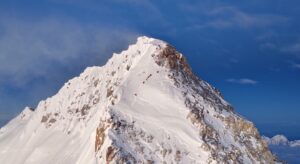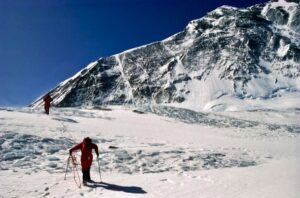With our fragile, hairless bodies and inconvenient need for oxygen, humans are not designed to withstand conditions at the top of the world. The microbes that call our noses and mouths home, however, have fewer issues.
Scientists studying soil samples collected from Everest Camp IV (otherwise known as the South Col) found a “human signature” of frozen microorganisms. The microbes got there in an unsurprising way — hitching a ride up the side of Everest in the noses, throats, and skin of climbers.
What surprised researchers was that some of these organisms — including Staphylococcus and Streptococcus — could remain dormant but viable for hundreds of years in Everest’s harsh conditions.
The study, published in Arctic, Antarctic, and Alpine Research, marks the first time researchers have conclusively identified human-associated microbes from samples around 8,000m.

A graphic from Genetic analysis of the frozen microbiome at 7900 m a.s.l., on the South Col of Sagarmatha (Mount Everest). Figure a. showcases the route taken to the collection point. Figure b. is a photograph of Camp IV, and figure c. is a close-up of the sample collection site.
“If somebody even blew their nose or coughed, that’s the kind of thing that might show up,” Steve Schmidt, a professor of ecology and evolutionary biology at CU Boulder and chief author of the paper, told the school in an interview.
The human-associated microbes identified in the study are a relatively small fraction of the organisms around Camp IV. Scientists found mostly extremophiles: microbes that evolved to live in earth’s harshest conditions. When discussing the South Col, those conditions include intense ultraviolet light, crushingly cold temperatures, and a lack of liquid water.
That’s why it’s so impressive that some human-associated microbes can survive there alongside their hardier brethren. The human throat is many things, but cold, dry, and bright? Not really.
A guest that never leaves
As someone who just contracted and recovered from a particularly juicy strain of Norovirus, I initially found the idea of “Everest-adapted Staph” horrifying.
But a close read of the paper reveals little cause for alarm on behalf of Everest’s yearly drove of climbers. There’s a difference between “survival” and “active replication” for microorganisms at such altitudes. If Everest climbers get sick, it’s from passing germs back and forth between themselves, not from stray microbes frozen at Camp IV.
According to Schmidt and his co-authors, the real worry is that their research proves that once human-associated microorganisms reach such unforgiving locations, they tend to stick around more or less forever.
“Our data suggest that the South Col and other extremely high-elevation environments may be deep-freeze collection points for deposited organisms, including human-borne contaminants that may never leave once they arrive,” they write.
The upshot is that once humans start exploring other worlds, we must be very careful of what we leave behind. Our microorganisms could interact with alien life in surprising and potentially damaging ways.
And once that genie is out of the bottle, there’s no way of putting it back in.

Mount Everest, Camp 4. Photo: Screenshot/Lisaclimbs






